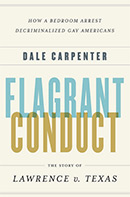Flagrant Conduct: The Story of Lawrence v. Texas: How a Bedroom Arrest Decriminalized Gay Americans
 Author: Dale Carpenter
Author: Dale Carpenter
New York: W. W. Norton & Co., 2012. 345 p.
Reviewer: Carlos A. Ball | July 2012
In 1973, the Texas legislature went on a decriminalization binge of sorts. As part of its first comprehensive reform of the state’s criminal code since it was adopted in 1856, the legislature decriminalized adultery, fornication, seduction (on the promise to marriage), and even bestiality. Lawmakers also decriminalized sodomy between two adults of different genders. Yet, in a decision that would have significant constitutional implications thirty years later, the legislature, for the first time, specifically criminalized same-sex sodomy.
Until then, the state’s sodomy proscription, like those of most jurisdictions, had prohibited individuals from engaging in particular sexual acts, primarily anal and oral sex. In contrast, under the new law, whether the sexual acts in question were criminal depended on the gender of the parties. The new law, in other words, was not meant to discourage particular sexual acts; instead, the law targeted how certain individuals—those who engaged in same-sex sexual acts—pursued sexual intimacy and pleasure. The Texas legislature made its purpose clear when it named the new statute the “Homosexual Conduct Law.”
Texas became only the second state to amend its sodomy law in this way—the first was Kansas in 1969. In the years that followed, Arkansas, Kentucky, Missouri, Montana, Nevada, and Tennessee also decriminalized opposite-sex sodomy while, for the first time, explicitly prohibiting the same-sex variety. Around the same time, several other states followed the Model Penal Code by completely decriminalizing consensual sodomy between adults.
In his book Flagrant Conduct, University of Minnesota law Professor Dale Carpenter provides a fascinating account of the successful constitutional challenge to the Texas statute that began in 1998 and culminated with the Supreme Court ruling in Lawrence v. Texas in 2003. As Carpenter accurately explains, the Homosexual Conduct Law was never about its criminal enforcement. Prosecutions for private, consensual sodomy were rare before 1973, and they remained so afterwards. Instead, the statute represented a powerful repudiation of gay people and their relationships. The sodomy law, in effect, rendered every sexually active lesbian, gay, and bisexual person in the state a criminal. In doing so, it legitimized the ways in which public and private actors discriminated against gay people in civil matters ranging from custody and visitation rights to access to employment and housing.
It was in many ways appropriate that a statute that was never really about sodomy ended up being successfully challenged in a case in which there may have been no sodomy. Carpenter, who seems to have interviewed everyone associated with the case, convincingly argues that it is unlikely that John Lawrence and Tyron Garner were engaged in sodomy when four Houston-area deputy sheriff officers—responding to a false report of someone wielding a gun in the premises—stormed into Lawrence’s apartment in the fall of 1998. As Carpenter explains, if the officers had simply left the apartment after not finding a weapon, it is likely that sodomy laws would still be constitutional today. Instead, the officers, apparently annoyed by the false report called in by Garner’s jealous boyfriend, and seemingly disturbed by the gay pornography they found in the apartment, decided to arrest the two men and charge them under the Homosexual Conduct Law.
For purposes of the constitutional challenge to the statute, it was immaterial whether the police officers actually observed Lawrence and Garner engaged in sodomy. Once the defendants decided to challenge the misdemeanor law under which they were arrested rather than pay fines and leave it at that, their lawyers, the prosecutors, and the courts operated under the assumption that the police officers’ version of events was accurate. In challenging the authority of the state to criminalize private sexual conduct between two adults of the same sex, the defendants and their gay rights attorneys raised questions that were exclusively legal and not dependent on the actual facts of the case. As a result, the judicial system did not determine whether Lawrence, as he told Carpenter in an interview, was watching television with Garner when the officers rushed into the apartment.
Even if it did not matter, for purposes of the constitutional challenge, whether the police officers observed the two men engaged in sodomy, that does not mean that their likely failure to do so was inconsequential. As Carpenter explains, the arrest in Lawrence’s home exposed the ways in which sodomy statutes afforded law enforcement officials the opportunity and incentive to exercise their authority in an abusive manner. Although “[a]ny law may be abused [and] evidence can be fabricated against anyone[,] . . . the danger is especially acute where the law has taught prejudice against a class, where enforcement is rare, where the activity itself is considered not just illegal but deeply shameful and literally indefensible, and where the effect of this shame is to inhibit all challenge” (pp. 107–08).
Carpenter notes that “because of the shame long associated with homosexuality and homosexual acts” (p. 14), those who had previously been ensnared by Texas’s sodomy statute pled guilty and paid fines rather than challenge the legitimacy of the law and its enforcement. He adds that by instilling deep shame “in its targets, the law insulated itself against the checking function that our criminal procedural guarantees are supposed to serve” (p. 108).
Certainly, the path of least resistance for Lawrence and Garner would have been to plead guilty, pay the applicable fines, and move on with their lives. Yet, the two men—neither of whom had ever participated in political activism of any kind—decided to follow their lawyers’ advice and challenge the law’s constitutionality. In defending the statute, the district attorney’s office offered only one ostensible legitimate justification for its enactment: the authority of the state to criminalize conduct that a majority of citizens believe to be immoral. As a result, much of the constitutional wrangling in the case revolved around the question of whether moral disapproval, by itself, constitutes a legitimate ground for the criminalization of conduct.
The Supreme Court in Bowers v. Hardwick had infamously answered that question in the affirmative. In Lawrence, however, the Court accepted the gay rights movement’s long-held position that the government must have an interest that is independent of majoritarian moral judgments before it can regulate the consensual sexual conduct of individuals.
But Lawrence did more than this. A case that started with an allegation that the two defendants had engaged in a sexual act that was traditionally viewed as shameful and debasing, led to a ruling by the nation’s highest court recognizing that gay people, like heterosexuals, enjoy autonomy and dignity interests that require the state to respect their choices in matters of sexual intimacy. I am sure that none of the Texas legislators who voted for the Homosexual Conduct Law in 1973 ever imagined that their sodomy statute would lead the Supreme Court, thirty years later, to acknowledge that the intimacy choices of lesbians, gay men, and bisexuals are worthy of constitutional respect.
Carpenter has done a marvelous job exploring every historical, political, social, and legal facet of the case. In doing so, he provides a comprehensive and moving account of the ebb and flow of national and local efforts to advance gay rights position leading up to the litigation. In one particularly superb chapter, Carpenter recounts the fledgling efforts by the gay community in Houston to become politically influential starting in the 1970s. Although, during the two decades that followed, the local gay community in that conservative city lost as many political battles as it won, progress—as defined by a growing awareness of the legitimacy of gay rights claims—was undoubtedly made. This meant that by the time the deputy sheriffs arrested Lawrence and Garner, there were organizations and individuals willing and able to help manage the political ramifications of the case, while assisting the lawyers in educating the public about how the mere existence of sodomy laws harmed gay people in tangible ways.
Carpenter has written the definitive history of Lawrence v. Texas. There may be aspects of the case that are not in the book, but they are unlikely to be significant or consequential. Carpenter is as good of a writer and reporter as he is a legal analyst and commentator. The result is an extremely readable, insightful, and important book.
Carlos A. Ball is Professor at Rutgers University School of Law (Newark).


